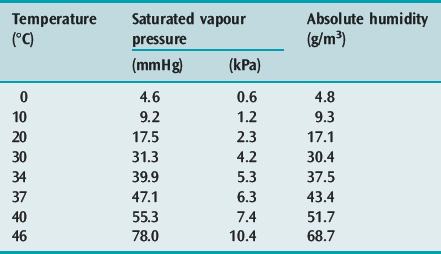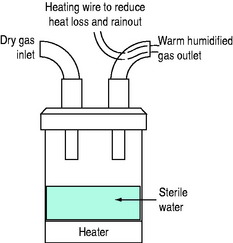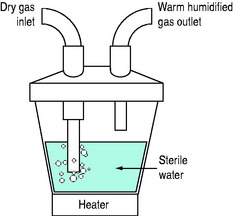Chapter 28 Humidification and inhalation therapy
The upper airway normally warms, moistens and filters inspired gas. When these functions are impaired by disease, or when the nasopharynx is bypassed by endotracheal intubation, artificial humidification of inspired gases must be provided.
PHYSICAL PRINCIPLES
Humidity, the amount of water vapour in a gas, may be expressed as:
PHYSIOLOGY
The nasal mucosa has a large surface area with an extensive vascular network which humidifies and warms inhaled gas more effectively than during mouth-breathing. Heating and humidification of dry gas are progressive down the airway, with an isothermic saturation boundary (i.e. 100% RH at 37°C or AH of 43 g/m3) just below the carina.1 Under resting conditions, approximately 250 ml of water and 1.5 kJ (350 kcal) of energy is lost from the respiratory tract in a day. A proportion (10–25%) is returned to the mucosa during expiration due to condensation.
The minimal moisture level to maintain ciliary function and mucus clearance is uncertain. Although reproducing an isothermic saturation boundary at the carina may be ideal, it does not seem essential in all situations. Mucus flow is markedly reduced when RH at 37°C falls below 75% (AH of 32 g/m3), and ceases when RH is 50% (AH of 22 g/m3).2 This suggests that an AH exceeding 33 g/m3 is needed to maintain normal function. At this AH level, inspired gas temperature does not appear to be important unless excessive.3 Mucociliary function is also impaired by upper respiratory tract infection, chronic bronchitis, cystic fibrosis, bronchiectasis, immotile cilia syndrome (including Kartagener’s syndrome), dehydration, hyperventilation, general anaesthetics, opioids, atropine and exposure to noxious gases. High fractional inspired oxygen concentrations (FiO2) may lead to acute tracheobronchitis, with depressed tracheal mucus velocity within 3 h.4 Inhaled β2-adrenergic agonists increase mucociliary clearance by augmenting ciliary beat frequency, and mucus and water secretion.5
CLINICAL APPLICATIONS OF HUMIDIFICATION
TRACHEAL INTUBATION
The need for humidification during endotracheal intubation and tracheostomy is unquestioned. As the upper airway is bypassed, RH of inspired gas falls below 50% with adverse effects, including:6
HEAT EXCHANGE
The respiratory tract is an important avenue to adjust body temperature by heat exchange. Humidification of gases reduces the fall in body temperature associated with anaesthesia and surgery.6 In this setting, active humidifiers are of no benefit over heat and moisture exchangers (HMEs).8 Excessive heat from humidification may produce mucosal damage, hyperthermia and overhumidification.9 However, if water content is not excessive, mucociliary clearance is unaffected up to temperatures of 42°C.3 Overhumidification may increase secretions and impair mucociliary clearance and surfactant activity, resulting in atelectasis.9
IDEAL HUMIDIFICATION
The basic requirements of a humidifier should include the following features:10
METHODS AND DEVICES
WATER BATH HUMIDIFIERS
HOT-WATER HUMIDIFIERS (FigureS 28.1 and 28.2)
Inspired gas is passed over (i.e. blow-by humidifier, e.g. Fisher–Paykel, Fisher and Paykel Medical, New Zealand) or through (i.e. bubble or cascade humidifier, e.g. Bennett Cascade, Bennett Medical Equipment, USA) a heated-water reservoir. Gas leaving the reservoir theoretically contains high water content. The water bath temperature is thermostatically controlled (e.g. at 45–60°C) to compensate for cooling along the inspiratory tubing targeting an inspired RH of 100% at 37°C. A heated wire may be sited in the inspiratory tubing to maintain preset gastemperature and humidity (e.g. Fisher–Paykel humidifier). It is commonly believed that hot-water humidifiers do not produce aerosols, but microdroplets (mostly less than 5 μm diameter) have been reported with bubble humidifiers,11 and this may be a potential source of infection.
Fisher–Paykel humidifier
Although these humidifiers are often regarded as providing optimal humidification in ventilated patients, their performance is lower than expected (36 mg/l with MR 850 with the outlet temperature set to 37°C and the delivery hose set at 40°C, and optimal conditions in bench studies, and up to 41.9 mg/l in practice).12 However, under conditions of high ambient temperature and/or high ventilator output temperature the inlet temperature to the humidification chamber can be high enough that the heater base operates at a low enough temperature that humidification is impaired,with reduction in inspired water content as low as 19 mg/l in bench studies, and 23.4 mg/l in practice.12 The automatic compensation now available on this humidifier helps compensate for poor performance, which can also be prevented by setting the chamber outlet and hose to 40°C. High minute ventilation is well tolerated, but a small decrease in water content output has also been found with higher respiratory rates.13
HEAT AND MOISTURE EXCHANGERS
Modern HMEs are popular intensive care unit (ICU) humidifiers due to their simplicity and increased efficiency. They all work on the basic principle of heat and moisture conservation during expiration, allowing inspired gas to be heated and humidified. HMEs may be hydrophobic or hygroscopic, and may also act as a microbial filter (HMEF). However, since nosocomial pneumonia is primarily due to aspiration of oropharyngeal secretions followed by secondary ventilator tubing colonisation, HMEFs have not been shown to reduce the frequency of nosocomial pneumonia, and the incidence is similar when HMEs and hot-water humidifiers are compared during prolonged ventilation.14,15
Modern HMEs are light with a small dead space (30–95 ml), but are varied in their level of humidification. Hygroscopic HMEs adsorb moisture on to a foam or paper-like material that is chemically coated (often calcium chloride or lithium chloride), and this tends to increase their efficiency (i.e. AH around 30 g/m3) compared to hydrophobic HMEs (i.e. AH 20–25 g/m3).16–21 The efficiency of older HMEs decreases with time;13 however, modern HMEs may retain their ability to humidify for at least 4 days with minimal change in resistance.22 Consequently, HMEs that achieve relatively high AH may be suitable for long-term mechanical ventilation in selected patients, particularly as the majority of reported HME complications (e.g. thick secretions and endotracheal tube occlusion) occurred with units of lower humidification levels.23–25 Nevertheless, HMEs increase dead space and imposed work of breathing, and cannot match the humidification offered by hot-water humidifiers, which remain the ‘gold standard’, particularly if secretions are thick or bloody, minute ventilation is high,15,19 humidification is necessary for more than 4 days26 or if used in children and neonates.

Full access? Get Clinical Tree








